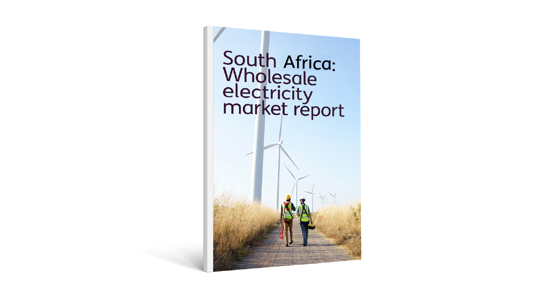
A market on the verge of major change: insights from Baringa’s South Africa Wholesale Electricity Market Report
4 min read 20 August 2025
As South Africa's energy market takes its first steps towards liberalisation, development and investment potential abounds. However, significant barriers remain on the journey to a reliable, competitive, and decarbonised energy system. We explore the risks and opportunities in this rapidly evolving landscape.
The Republic of South Africa (RSA) is the largest power generator in Africa. In 2024, annual gross demand reached 219.6 TWh, driven largely by industrial sectors including mining and manufacturing.
Baringa’s South Africa Wholesale Electricity Market Report provides a comprehensive, independent analysis of this dynamic market. Exploring energy policies, regulatory developments, demand-supply dynamics, and wholesale power price projections, our report reveals a power sector primed for significant transformation.
A more diversified and competitive electricity market
For decades, the electricity market in South Africa has been dominated by state-owned utility Eskom, which has operated as a near-monopolistic single buyer. This paradigm is set to change, however, as the market enters the early stages of liberalisation.
Eskom is being unbundled into generation, distribution service operator (DSO), and transmission service operator (TSO) arms. The TSO arm, the National Transmission Company of South Africa (NTCSA), was established in mid-2024.
At the same time, the South African Wholesale Electricity Market (SAWEM) is being established. A Draft Market Code was issued in 2024, with operations are expected to start in phases. Balancing mechanisms and limited trading could be launched as early as 2026, while full market liberalisation has been targeted for 2031.
These developments represent one of Africa's most significant energy market reforms, creating opportunities for both local and international participants across the entire electricity value chain.
Independent power producers (IPPs) stand to benefit from greater market access, bringing with it the potential for increased returns and new revenue streams. The reforms will provide traders with more flexibility, allowing them to procure electricity from private generators or the open market. Beyond the addition of new generation capacity, liberalisation also lays the foundation for new market platforms, including balancing, day-ahead, and intra-day markets, further expanding available opportunities.
Liberalisation opens inroads for renewables development
Coal has long been the mainstay of South Africa’s energy mix, accounting for more than 80% of current electricity generation capacity. However, the share of low-carbon technologies is slowly growing. With the transition away from Eskom's monopoly, developers have greater scope to pursue projects across diverse technologies including solar, wind, gas, and battery energy storage solutions (BESS).
Currently, 16.7% of electricity production comes from low-carbon sources, with solar and wind generation accounting for 12.7%. Government subsidy schemes stimulating renewables growth by encouraging public-private partnerships with IPPs to develop sustainable energy facilities.
Three key programmes that merit investor attention are the Renewable Energy Independent Power Producer Procurement Programme (REIPPPP) for renewable energy, the Battery Energy Storage Independent Power Producers Procurement Programme (BESIPPPP), and the Gas IPP Procurement Programme (GIPPPP). IPPPP bid windows enable generators to secure 15- to 20-year power purchase agreements (PPAs) with the National Transmission Company of South Africa (NTCSA), providing significant revenue stream de-risking for renewables, BESS, and gas plants.
The country has targeted 18GW of wind and 8GW of solar capacity by 2030 (Ember Energy, 2030 Global Renewable Target Tracker). To date, a total of 148 projects have been awarded to the private sector, with c. 6.5 GW of wind and solar having reached commercial operation (IPPP Programme Status). Meanwhile, the government’s upcoming round of procurement calls for more than 5,000 MW of new renewable generation capacity from IPPs (Department of Mineral Resources and Energy, National Council of Provinces budget vote speech).
Finance will play a key role in fueling market transformation
Private capital financing will be critical to accelerating investments in renewable energy and new generation capacity. Substantial investment is required not only for developing new gas, solar, wind generation, and energy storage facilities, but also for adding much-needed distribution and transmission capacity while supporting grid modernisation. Major banks such as Nedbank, ABSA, and Standard Bank, along with DFIs like DBSA, IFC, and AfDB, remain active in funding utility-scale power projects.
The government has been taking steps to incentivise and accelerate private investment. A 2024 amendment to the Electricity Regulation Act removed size limits on private sector energy project investments. Permitting and licensing procedures have also been simplified to speed up grid connections and facilitate easier production and sale of electricity. However, with the wholesale power market liberalisation still underway and some structures still unclear, policy risk remains a barrier.
Demand growth and renewable expansion on the horizon
Sound investment and risk management require reliable insights into future energy capacity, demand, and pricing. Using fundamentals-based power system modelling, Baringa provides robust outlooks for key market drivers and power prices.
Our projections cover three key scenarios:
| 1 - Reference Case | 2 - Low Commodities | 3 - High Commodities |
| Our central view on the evolution of the power market, where the South African government continues to pursue an energy policy that balances security of supply, affordability and sustainability. |
Lower commodity/carbon prices and slower renewables growth driving slower decarbonisation (versus our Reference Case).
|
Higher commodity/carbon prices and faster renewables growth resulting in quicker, deeper decarbonisation (versus our Reference Case).
|
Across all three scenarios, we project demand in South Africa to grow by 45% between 2025 and 2050, with manufacturing and mining sectors expected to see the largest absolute growth. We also project rising coal prices and carbon costs, while gas prices should initially fall up until 2030 and slowly increase thereafter.
In our Reference Case, we project a marked increase in renewables. Onshore wind generation is likely to dominate renewable energy generation share, with the most rapid growth projected after the mid-2030s.
On a generation basis, we project the share of solar PV and wind to increase from 15.6% in 2025 to 75% in 2050, while coal-fired generation falls from 76% in 2025 to 9% in 2050. We anticipate that the generation mix will become increasingly dominated by intermittent renewable generation, with gas capacity and batteries providing flexible generation support.
Supporting smarter investment decisions
Baringa’s power market insights and projections represent the gold standard in scenario-based analysis. Investors, lenders, and project developers trust our reports to support major power market investments and deal assessments.
Discover our full range of price projections and market insights in Baringa’s South Africa Wholesale Electricity Market Report. If you want to go further with tailor-made market analysis and investment guidance, reach out to our experts to take the next step.

South Africa: Wholesale electricity market report
The South Africa Reference Case Report covers our half-yearly updated analysis of the power market in South Africa up to 2060.
Read moreIs digital and AI delivering what your business needs?
Digital and AI can solve your toughest challenges and elevate your business performance. But success isn’t always straightforward. Where can you unlock opportunity? And what does it take to set the foundation for lasting success?